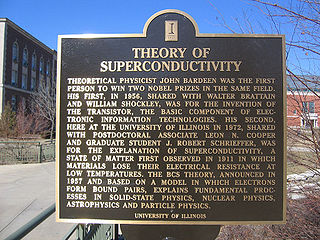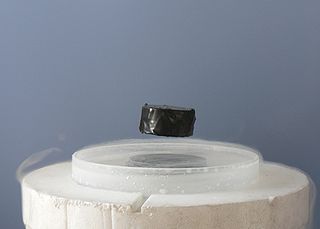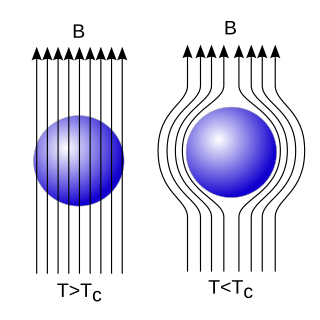
BCS theory or Bardeen–Cooper–Schrieffer theory is the first microscopic theory of superconductivity since Heike Kamerlingh Onnes's 1911 discovery. The theory describes superconductivity as a microscopic effect caused by a condensation of Cooper pairs. The theory is also used in nuclear physics to describe the pairing interaction between nucleons in an atomic nucleus.

Superconductivity is a set of physical properties observed in certain materials where electrical resistance vanishes and magnetic fields are expelled from the material. Any material exhibiting these properties is a superconductor. Unlike an ordinary metallic conductor, whose resistance decreases gradually as its temperature is lowered, even down to near absolute zero, a superconductor has a characteristic critical temperature below which the resistance drops abruptly to zero. An electric current through a loop of superconducting wire can persist indefinitely with no power source.
Unconventional superconductors are materials that display superconductivity which does not conform to conventional BCS theory or its extensions.

The Meissner effect is the expulsion of a magnetic field from a superconductor during its transition to the superconducting state when it is cooled below the critical temperature. This expulsion will repel a nearby magnet.
The magnetic flux, represented by the symbol Φ, threading some contour or loop is defined as the magnetic field B multiplied by the loop area S, i.e. Φ = B ⋅ S. Both B and S can be arbitrary, meaning Φ can be as well. However, if one deals with the superconducting loop or a hole in a bulk superconductor, the magnetic flux threading such a hole/loop is quantized. The (superconducting) magnetic flux quantumΦ0 = h/(2e) ≈ 2.067833848...×10−15 Wb is a combination of fundamental physical constants: the Planck constant h and the electron charge e. Its value is, therefore, the same for any superconductor. The phenomenon of flux quantization was discovered experimentally by B. S. Deaver and W. M. Fairbank and, independently, by R. Doll and M. Näbauer, in 1961. The quantization of magnetic flux is closely related to the Little–Parks effect, but was predicted earlier by Fritz London in 1948 using a phenomenological model.
In physics, Ginzburg–Landau theory, often called Landau–Ginzburg theory, named after Vitaly Ginzburg and Lev Landau, is a mathematical physical theory used to describe superconductivity. In its initial form, it was postulated as a phenomenological model which could describe type-I superconductors without examining their microscopic properties. One GL-type superconductor is the famous YBCO, and generally all Cuprates.

Magnesium diboride is the inorganic compound with the formula MgB2. It is a dark gray, water-insoluble solid. The compound has attracted attention because it becomes superconducting at 39 K (−234 °C). In terms of its composition, MgB2 differs strikingly from most low-temperature superconductors, which feature mainly transition metals. Its superconducting mechanism is primarily described by BCS theory.

A superconducting magnet is an electromagnet made from coils of superconducting wire. They must be cooled to cryogenic temperatures during operation. In its superconducting state the wire has no electrical resistance and therefore can conduct much larger electric currents than ordinary wire, creating intense magnetic fields. Superconducting magnets can produce stronger magnetic fields than all but the strongest non-superconducting electromagnets, and large superconducting magnets can be cheaper to operate because no energy is dissipated as heat in the windings. They are used in MRI instruments in hospitals, and in scientific equipment such as NMR spectrometers, mass spectrometers, fusion reactors and particle accelerators. They are also used for levitation, guidance and propulsion in a magnetic levitation (maglev) railway system being constructed in Japan.

Flux pinning is a phenomenon that occurs when flux vortices in a type-II superconductor are prevented from moving within the bulk of the superconductor, so that the magnetic field lines are "pinned" to those locations. The superconductor must be a type-II superconductor because type-I superconductors cannot be penetrated by magnetic fields. Some type-I superconductors can experience the effects of flux pinning if they are thin enough. If the material's thickness is comparable to the London penetration depth, the magnetic field can pass through the material. The act of magnetic penetration is what makes flux pinning possible. At higher magnetic fields the superconductor allows magnetic flux to enter in quantized packets surrounded by a superconducting current vortex. These sites of penetration are known as flux tubes. The number of flux tubes per unit area is proportional to the magnetic field with a constant of proportionality equal to the magnetic flux quantum. On a simple 76 millimeter diameter, 1-micrometer thick disk, next to a magnetic field of 28 kA/m, there are approximately 100 billion flux tubes that hold 70,000 times the superconductor's weight. At lower temperatures the flux tubes are pinned in place and cannot move. This pinning is what holds the superconductor in place thereby allowing it to levitate. This phenomenon is closely related to the Meissner effect, though with one crucial difference — the Meissner effect shields the superconductor from all magnetic fields causing repulsion, unlike the pinned state of the superconductor disk which pins flux, and the superconductor in place.
The Little–Parks effect was discovered in 1962 by William A. Little and Ronald D. Parks in experiments with empty and thin-walled superconducting cylinders subjected to a parallel magnetic field. It was one of the first experiments to indicate the importance of Cooper-pairing principle in BCS theory.

Superconductivity is the phenomenon of certain materials exhibiting zero electrical resistance and the expulsion of magnetic fields below a characteristic temperature. The history of superconductivity began with Dutch physicist Heike Kamerlingh Onnes's discovery of superconductivity in mercury in 1911. Since then, many other superconducting materials have been discovered and the theory of superconductivity has been developed. These subjects remain active areas of study in the field of condensed matter physics.

Superdiamagnetism is a phenomenon occurring in certain materials at low temperatures, characterised by the complete absence of magnetic permeability and the exclusion of the interior magnetic field.

In superconductivity, fluxon is a vortex of supercurrent in a type-II superconductor, used by Alexei Abrikosov to explain magnetic behavior of type-II superconductors. Abrikosov vortices occur generically in the Ginzburg–Landau theory of superconductivity.

In superconductivity, a type-II superconductor is a superconductor that exhibits an intermediate phase of mixed ordinary and superconducting properties at intermediate temperature and fields above the superconducting phases. It also features the formation of magnetic field vortices with an applied external magnetic field. This occurs above a certain critical field strength Hc1. The vortex density increases with increasing field strength. At a higher critical field Hc2, superconductivity is destroyed. Type-II superconductors do not exhibit a complete Meissner effect.

The interior of a bulk superconductor cannot be penetrated by a weak magnetic field, a phenomenon known as the Meissner effect. When the applied magnetic field becomes too large, superconductivity breaks down. Superconductors can be divided into two types according to how this breakdown occurs. In type-I superconductors, superconductivity is abruptly destroyed via a first order phase transition when the strength of the applied field rises above a critical value Hc. This type of superconductivity is normally exhibited by pure metals, e.g. aluminium, lead, and mercury. The only alloy known up to now which exhibits type I superconductivity is tantalum silicide (TaSi2). The covalent superconductor SiC:B, silicon carbide heavily doped with boron, is also type-I.

Proximity effect or Holm–Meissner effect is a term used in the field of superconductivity to describe phenomena that occur when a superconductor (S) is placed in contact with a "normal" (N) non-superconductor. Typically the critical temperature of the superconductor is suppressed and signs of weak superconductivity are observed in the normal material over mesoscopic distances. The proximity effect is known since the pioneering work by R. Holm and W. Meissner. They have observed zero resistance in SNS pressed contacts, in which two superconducting metals are separated by a thin film of a non-superconducting metal. The discovery of the supercurrent in SNS contacts is sometimes mistakenly attributed to Brian Josephson's 1962 work, yet the effect was known long before his publication and was understood as the proximity effect.
Type-1.5 superconductors are multicomponent superconductors characterized by two or more coherence lengths, at least one of which is shorter than the magnetic field penetration length , and at least one of which is longer. This is in contrast to single-component superconductors, where there is only one coherence length and the superconductor is necessarily either type 1 or type 2. When placed in magnetic field, type-1.5 superconductors should form quantum vortices: magnetic-flux-carrying excitations. They allow magnetic field to pass through superconductors due to a vortex-like circulation of superconducting particles. In type-1.5 superconductors these vortices have long-range attractive, short-range repulsive interaction. As a consequence a type-1.5 superconductor in a magnetic field can form a phase separation into domains with expelled magnetic field and clusters of quantum vortices which are bound together by attractive intervortex forces. The domains of the Meissner state retain the two-component superconductivity, while in the vortex clusters one of the superconducting components is suppressed. Thus such materials should allow coexistence of various properties of type-I and type-II superconductors.
Flux pumping is a method for magnetising superconductors to fields in excess of 15 teslas. The method can be applied to any type II superconductor and exploits a fundamental property of superconductors, namely their ability to support and maintain currents on the length scale of the superconductor. Conventional magnetic materials are magnetised on a molecular scale which means that superconductors can maintain a flux density orders of magnitude bigger than conventional materials. Flux pumping is especially significant when one bears in mind that all other methods of magnetising superconductors require application of a magnetic flux density at least as high as the final required field. This is not true of flux pumping.

Bean's critical state model, introduced by C. P. Bean in 1962, gives a macroscopic explanation of the irreversible magnetization behavior (hysteresis) of hard Type-II superconductors.
Macroscopic quantum phenomena are processes showing quantum behavior at the macroscopic scale, rather than at the atomic scale where quantum effects are prevalent. The best-known examples of macroscopic quantum phenomena are superfluidity and superconductivity; other examples include the quantum Hall effect and topological order. Since 2000 there has been extensive experimental work on quantum gases, particularly Bose–Einstein condensates.
















